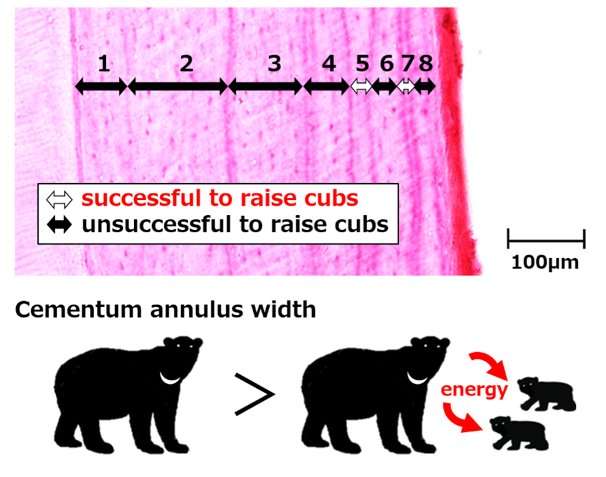Mom's teeth tell her history of giving birth and raising babies in Asian black bears

Scientists from Japanese institutions among Tokyo University of Agriculture and Technology (TUAT), Picchio Wildlife Research Center, National Agriculture and Food Research Organization, and Tokyo University of Agriculture have discovered that width of surface layers coating tooth's roots correlates with reproductive histories of female Asian black bears. When a female bear raised cubs, the layers of her teeth were much narrower compared to those when she was not. Thus, measuring layer width of female bears' teeth can be a useful index for their reproductive histories. This research was published online in the journal Mammal Study.
It is widely known that, like tree rings, growth lines are formed in teeth of mammals including humans. Such growth lines are called annulus or annual layers (annulus is the Latin word for "little ring"; its plural is annuli) and are periodically accumulated within cementum, which is a surface part coating the tooth's roots. The Cementum annuli tell us to estimate age in many kinds of mammals. Width of cementum annuli (hereafter, cementum annuli width) changes according to nutritional condition of individuals. It is unknown, however, what factors have effect on change of the cementum annuli width of Asian black bears (Ursus thibetanus; hereafter, bears).
"We hypothesized that lactation was a factor influencing cementum annuli width through changes of nutritional condition", said the first and corresponding author Ms Kahoko Tochigi, a graduate student at TUAT. "To test the hypothesis, we decided to examine teeth from adult female bears. We chose 13 female bears that had been monitored with collars from 2002 to 2017 in the Karuizawa Resort area of Nagano Prefecture and the Ashio-Nikko Mountains of Gunma and Tochigi prefectures in central Japan. In those areas, scientific bear surveys have been carried on for the last two decades."
Since bears do not use the first premolar teeth for eating, those researchers collected one first premolar tooth from each bear by using methods that have as little influence on bears as possible. Then proportional width index (PWI, used as an index of annular cementum growth) was measured and compared with reproductive status, such as females "with cubs" or "without cubs" by direct field observations.
"Interestingly, in years when females accompanied cubs, PWI was significantly smaller than in years when females were not accompanied cubs", said the senior author Dr. Shinsuke Koike, Associate professor at TUAT. "Our results indicate that reproductive success, giving birth and raising cubs, in female Asian black bears decreases cementum annuli width."
The reason why the cementum annulus in females becomes narrower during a breeding year is females invest their nutritional intake into cubs during periods of parturition and lactation, which impose large energy costs on the mothers.
"So cementum annulus width can to be a useful index of past reproductive histories of female bears as a life-history parameter. Our study will open new avenues to efficiently establish development in the field of reproductive ecology as well as monitoring and management bear population.
More information: Kahoko Tochigi et al, Reproductive Histories of Asian Black Bears Can be Determined by Cementum Annuli Width, Mammal Study (2018). DOI: 10.3106/ms2018-0016
Provided by Tokyo University of Agriculture and Technology


















